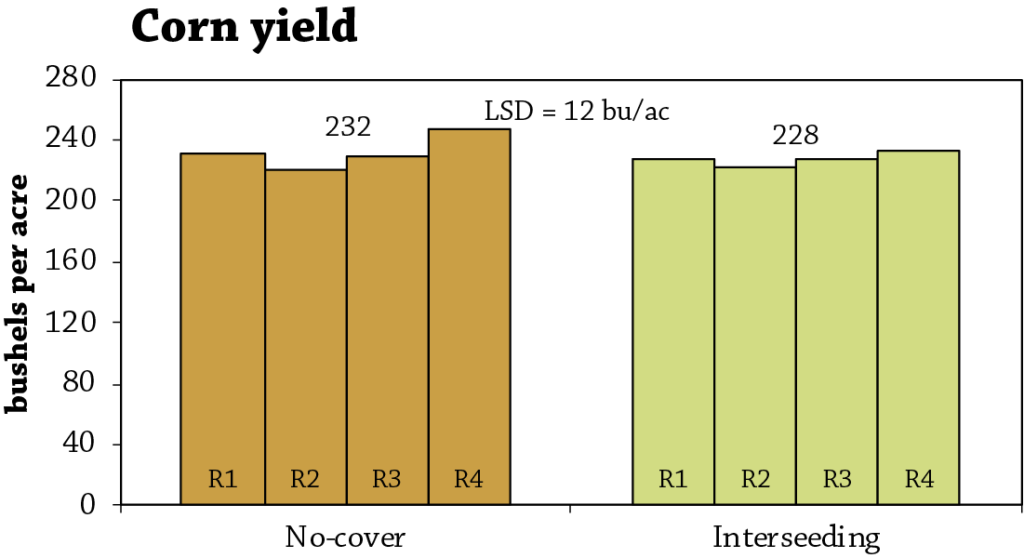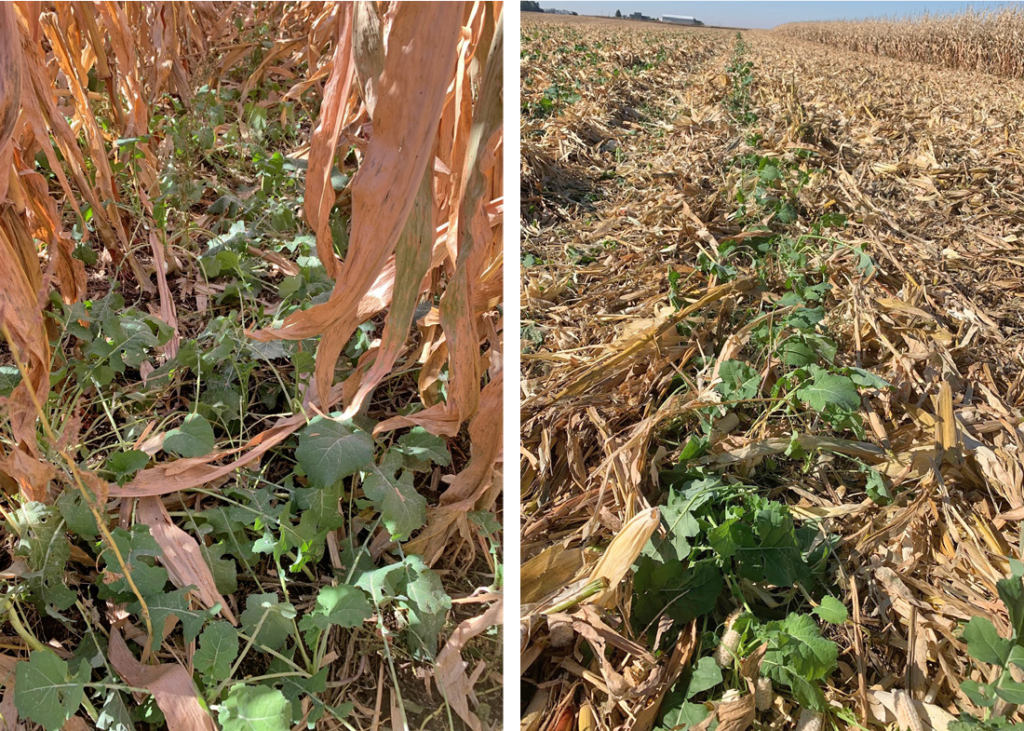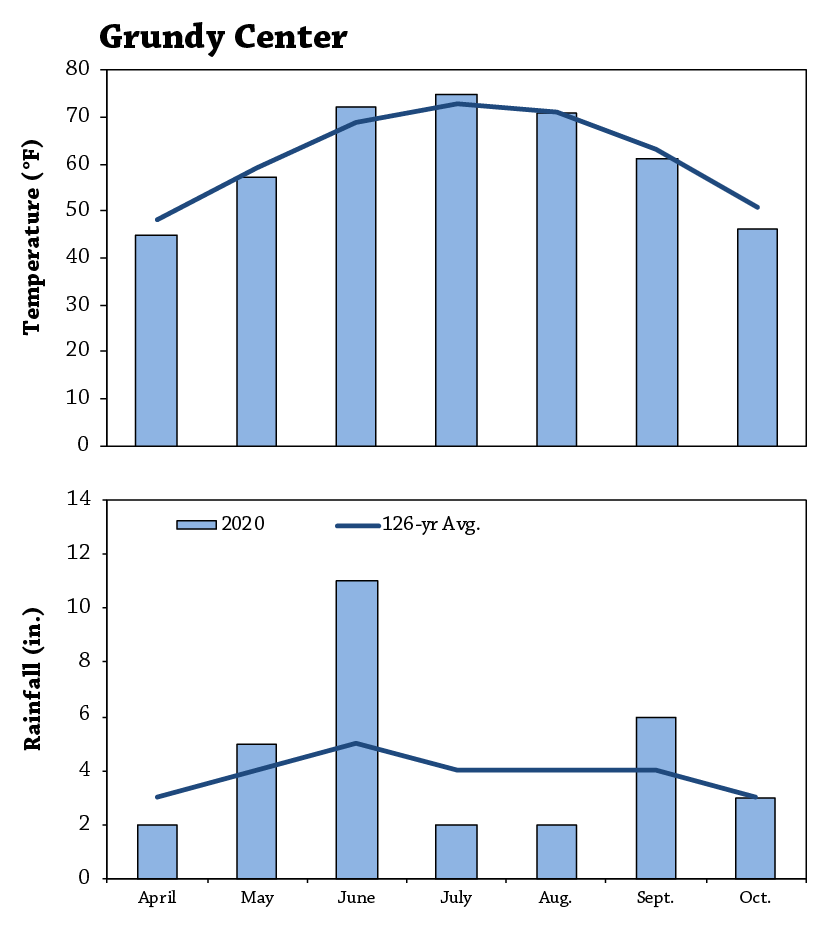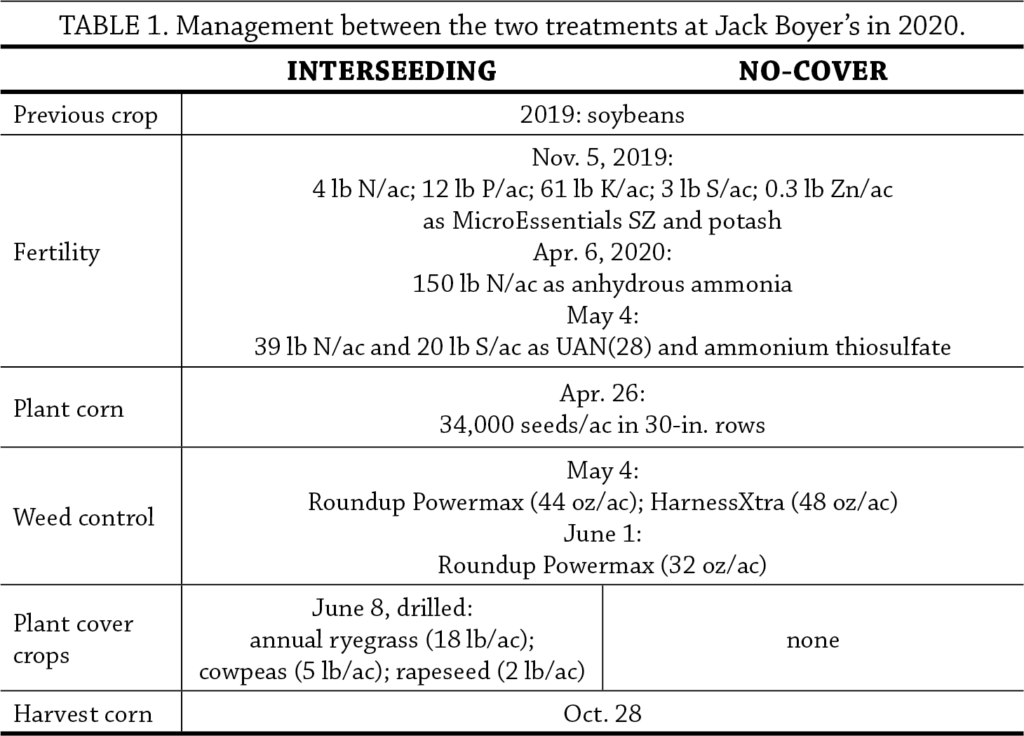This research was funded by Walton Family Foundation.
In a Nutshell:
- The appeal of interseeding a cover crop in June is twofold: 1). The seeding operation occurs at a relatively less busy time of year and 2). Seeding earlier in the year presents an opportunity for more cover crop growth and the attendant soil and water benefits compared to seeding a cover crop in the fall post-harvest.
- Jack Boyer hypothesized that interseeding annual ryegrass, cowpea and rapeseed cover crops to corn in June would successfully establish and persist through the year and that corn yield would be similar to where no cover crops were interseeded.
Key Findings:
- Visual inspection through the year showed that the interseeded cover crops successfully established and persisted through the year to corn harvest (particularly the rapeseed in the mix).
- Boyer observed no difference in corn yield between the interseeding and no-cover treatments. The interseeding cost an additional $43/ac (seed, drilling).

Annual ryegrass, cowpeas and rapeseed cover crops interseeded to corn at Jack Boyer’s in 2020. Cover crops were interseeded on June 8. At left, photo taken June 16. At right, photo taken Aug. 30.
Methods
Design
To test the effect of interseeding cover crops in June on corn yield, Boyer compared two treatments:
- Interseeding – interseed annual ryegrass, cowpeas and rapeseed cover crops to corn in early summer when corn reaches ~V4 stage or at layby (last pass through field);
- No-cover – No interseeded cover crops (control).
Boyer implemented four replications of the two treatments (Figure A1). Strips measured 30 ft wide by 2,450 ft long. Field management is presented in Table 1.
Measurements
Boyer harvested and recorded corn yields from each strip on Oct. 28. Corn grain yields were corrected to 15.5% moisture. Boyer visually inspected and captured photographs of interseeded cover crop performance through the growing season.
Data analysis
To evaluate the effect of interseeding on corn yield, we calculated treatment averages and then used a t-test to compute the least significant difference (LSDs) at the 95% confidence level. The difference between both treatments’ average corn yield is compared with the LSD. A difference greater than or equal to the LSD indicates the presence of a statistically significant treatment effect, meaning one treatment outperformed the other and Boyer could expect the same results to occur 95 out of 100 times under the same conditions. A difference smaller than the LSD indicates the difference is not statistically significant and the treatment had no effect.
Results and Discussion
Corn yield
Interseeding cover crops had no significant effect on corn yield (Figure 1). Boyer’s field average (230 bu/ac) exceeded the five-year Grundy County average (210 bu/ac).[4]

FIGURE 1. Corn yields at Jack Boyer’s, harvested on Oct. 28, 2020. Columns represent yields for each individual strip. Above each set of columns is the mean for both treatments. Because the observed difference between the two means (4 bu/ac) is less than the least significant difference (LSD; 12 bu/ac), the results are considered statistically similar at the 95% confidence level.
Economic considerations
Compared to the no-cover treatment, the interseeding treatment incurred extra expenses in the form of cover crop seed and drilling the cover crop on June 8 (Table 1). Boyer cited the cost of the cover crop seed mix ($25/ac) and we assigned a cost to drilling the cover crop ($18/ac) based on ISU Extension and Outreach survey data for 2020.[5] Ultimately, the interseeding treatment cost $43/ac more than the no-cover treatment with no improvement in corn yield (Figure 1).

By the time of corn harvest, rapeseed dominated the interseeded cover crop mix. Photos taken Oct. 28, 2020.
Conclusions and Next Steps
Successfully establishing a cover crop during the time of year with a lower workload on his farm is one of Boyer’s primary goals. As such, Boyer has been investigating the practice of interseeding cover crops to corn for several years. Those trials have involved seed corn,[6] corn leaf architecture [7] and wide cornrows.[8,9] Through all those trials, Boyer has been particularly interested in survival of the interseeded cover crop (and maintaining or potentially improving corn yield). In this trial, he was pleased to observe no negative effect on corn yield from the interseeded cover crop (Figure 1). Because yields were no different compared to where he did not interseed a cover crop, the interseeding reduced returns by $43/ac. Boyer was also satisfied by the performance of the interseeded annual ryegrass, cowpea and rapeseed cover crops based on visual inspections through the year (see photos). Ultimately, he would like to have more species in the mix for the purposes of increasing diversity and improving soil health on his farm.
Appendix – Trial Design and Weather Conditions

FIGURE A1. Jack Boyer’s experimental design included four replications of the two treatments (8 strips total). This design allowed for statistical analysis of the results.

FIGURE A2. Mean monthly temperature and rainfall for Apr. 1, 2020 through Oct. 31, 2020 and the long-term averages at the nearby Grundy Center weather station.[10]
References
- Lotjonen, T. and H. Mikkola. 2000. Three mechanical weed control techniques in spring cereals. Agricultural and Food Science. 9:269–278. https://journal.fi/afs/article/view/5668 (accessed November 2020).
- Rasmussen, J., H.H. Nielsen and H. Gundersen. 2009. Tolerance and Selectivity of Cereal Species and Cultivars to Postemergence Weed Harrowing. Weed Science. 57:338–345. https://bioone.org/journals/Weed-Science/volume-57/issue-3/WS-08-109.1/Tolerance-and-Selectivity-of-Cereal-Species-and-Cultivars-to-Postemergence/10.1614/WS-08-109.1.short (accessed November 2020).
- Weisberger, D., M.A. Smith, M.H. Wiedenhoeft, D. Fehr and D. Wilson. 2016. Evaluation of Rotary Hoe for Mechanical Weed Control in Organic Oats. Iowa Organic Association. https://www.iowaorganic.org/organic_research (accessed October 2020).
- US Department of Agriculture-National Agricultural Statistics Service. Quick stats. USDA-National Agricultural Statistics Service. https://quickstats.nass.usda.gov/ (accessed February 2021).
- Plastina, A., A. Johanns and O. Massman. 2020. 2020 Iowa Farm Custom Rate Survey. Iowa State University Extension and Outreach. https://www.extension.iastate.edu/agdm/crops/html/a3-10.html (accessed February 2021).
- Gailans, S. and J. Boyer. 2016. Interseeding Cover Crops in Seed Corn at the V4-V6 Stage. Practical Farmers of Iowa Cooperators’ Program. https://practicalfarmers.org/research/interseeding-cover-crops-in-seed-corn-at-the-v4-v6-stage/ (accessed October 2019).
- Gailans, S., J. Boyer and J. Gustafson. 2017. Corn Leaf Architecture for Interseeded Cover Crops. Practical Farmers of Iowa Cooperators’ Program. https://practicalfarmers.org/research/corn-leaf-architecture-for-interseeded-cover-crop/ (accessed May 2019).
- Gailans, S., J. Boyer, F. Abels, C. Teachout, B. Kessel, H. Kessel and J. Johnson. 2018. Planting Corn in 60-in. Row-Widths for Interseeding Cover Crops. Practical Farmers of Iowa Cooperators’ Program. https://practicalfarmers.org/research/planting-corn-in-60-in-row-widths-for-interseeding-cover-crops/
(accessed January 2021). - Gailans, S., F. Abels, R. Alexander, N. Anderson, J. Boyer and M. Yoder. 2019. Planting Corn in 60-in. Row-Widths for Interseeding Cover Crops. Practical Farmers of Iowa Cooperators’ Program. https://practicalfarmers.org/research/planting-corn-in-60-in-row-widths-for-interseeding-cover-crops-2/ (accessed January 2021).
- Iowa Environmental Mesonet. 2021. Climodat Reports. Iowa State University. http://mesonet.agron.iastate.edu/climodat/ (accessed January 2021).


